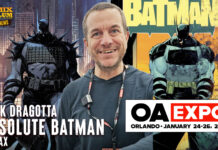Lighting is a powerful tool in visual storytelling, especially in the context of narrative films. When used effectively, light and color can transform a scene and guide the viewer’s emotions. Unique lighting in film allows filmmakers to convey complex emotions and themes, adding depth and richness to narratives. Let’s look at a few iconic examples of mood lighting throughout film history.
Double Indemnity (1944)
Billy Wilder’s landmark film noir relies heavily on mood lighting and sets an example for later films in the genre. Low-key light sources, hard shadows, and stark contrasts between black and white evoke protagonist Walter Neff’s moral struggle as he falls into the clutches of a femme fatale.
Psycho (1960)
Alfred Hitchcock used high-contrast, dramatic lighting to pull off a much more terrifying effect in what is perhaps his most famous film. In the infamous shower scene, those stark contrasts are as sharp and disorienting as the knife that brings Marion Crane’s story to a violent halt. The harsh shadows and bright highlights contribute to the startling effect of the scene and cement it as an iconic moment in horror cinema.
2001: A Space Odyssey (1968)
In this epic science-fiction saga, Stanley Kubrick used mood lighting to great effect in two distinct portions of the film. The “Dawn of Man” sequence in which the monolith first appears is lit with warm, soft shades that imbue it with a mystical and otherworldly aura. Later, on the spaceship Discovery, stark, cold lighting with bluish tones creates a sense of isolation and sterility within the craft.
Blade Runner (1982)
Since its inception, the science fiction genre frequently employs cold lighting to portray feelings of loneliness, dullness, and desolation. Lighting is crucial to film production not only to convey a mood, but to set the narrative in a time and place. Ridley Scott’s famous feature used a combination of neon lights and deep shadows to create a bleak, futuristic cityscape that mirrors the protagonist’s existential crisis.
Schindler’s List (1993)
A powerful and famous effect appears in Steven Spielberg’s haunting Holocaust narrative. The film is predominantly shot in black and white, lending it a stark, sobering quality. However, one key scene features a girl in a red coat; that single hue draws attention to the individual tragedies within the larger devastation. It’s a poignant image that lingers in the viewer’s mind.
Throughout the history of film, there are many iconic examples of mood lighting being used to great effect. Whether the filmmaker wishes to set their scene in a warm environment or thrust viewers into a character’s turbulent inner world, lighting helps them achieve that goal. Give these famous examples a watch and notice how the lighting impacts your experience.


































